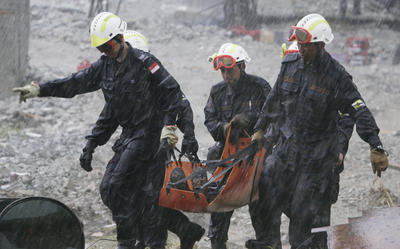The rise of NTS issues presents new challenges for developing a regional security architecture — What traditional and non-traditional issues can be considered true security issues? Does the state remain the exclusive actor of international politics? Does individual security derive from national security? How can the military adapt to non-traditional security issues?
Such questions present serious obstacles to establishing a formal security architecture in Asia for the NTS portfolio. Still, there remains a genuine regional interest in deepening multilateral and bilateral security cooperation, which has resulted in the strengthening of security cooperation on NTS issues despite the absence of formal security architecture.
First, it is necessary to define what constitutes a security issue today. Scholars have found that classical frameworks are not easily adapted to the contemporary security landscape. They instead turn to novel approaches to security studies, including ‘securitisation theory’. This concept provides an analytical framework which adapts well to both traditional and NTS issues as well as state and non-state actors. By focusing on whether a given issue represents an existential threat — typically to a state or non-state actor — securitisation theory enables analysts to both expand and limit the field of security issues.
Traditionally, adherents of securitisation theory recognise specific categories of security issues. According to Barry Buzan, these include five general categories: military, environmental, economic, societal and political issues. It is from broad categories such as these that Asian security analysts can distill individual risks and threats.
Academic Nick Bisley notes that numerous multilateral and bilateral forums already exist for security cooperation, ‘designed to build trust, foster regional confidence and improve information transfer’, they include the ASEAN Regional Forum (ARF) and East Asia Summit (EAS), as well as Track II security processes. Bilateral alliances, agreements, security dialogues, and mechanisms also provide an equally, if not more, effective means for cooperation on NTS issues.
The big question is if one from this plethora of existent institutions could evolve into a more formal security architecture? Such broadening and deepening would likely require the development of core attributes such as legitimacy, inclusiveness, focus, capacity and authority. With these observations in mind, Jim Rolfe suggests that ASEAN could play a central role in Asia Pacific security maintenance, but that would require it to ‘change its membership rules completely, widen its focus … and become more centralized in its approach to issues’. ASEAN would also need to abandon its traditional maxim of advancing non-intervention policies. Given this, the ability for ASEAN Plus Three (APT), EAS, APEC or ARF to immediately assume this role is questionable.
Among existing institutions, David Arase suggests that the China–ASEAN relationship may provide the best candidate. According to Arase, ‘China–ASEAN [NTS] cooperation [already] has become an institutionalized process that affects both the strategic and political future of East Asia’. Arase believes that ‘this meeting-driven process constituting China–ASEAN economic and security cooperation has advanced concrete security cooperation schemes far more than either [APEC] or [APT]’. In his view, the relationship needs only to expand to include other APT members (Japan and South Korea) to provide a nascent East Asian security architecture.
However, Arase’s assessment presumes that China realises absolute benefits from cooperation. At present this may be the case as China requires peace along its borders to advance economic growth and domestic stability. But, in the future, analysts question whether China will adopt new policies based upon its balance of power advantage. The threat that China will forgo cooperation for power politics therefore represents a major barrier to the development of a formal security regime and willingness of other states to legitimise China’s unchallenged leadership on NTS issues.
Whether any of the existing structures can evolve into a formal security regime remains a matter of academic debate. While countries such as Indonesia may be willing to promote new policies that depart from Asia’s non-interventionist and non-interference tradition, other states will be opposed. It seems likely Asia will also remain resistant to the participation of non-state actors in any future security regime, undermining its ability to effectively tackle regional NTS issues. Finally, Asia lacks a strong sense of community, presenting a formidable challenge to cooperation.
Eddie Walsh is a post-MA scholar at the Department of Southeast Asian Studies, Paul H. Nitze School of Advanced International Studies (SAIS), The Johns Hopkins University.


What is traditional or non traditional security? And also suggest some major steps to control non traditional security?